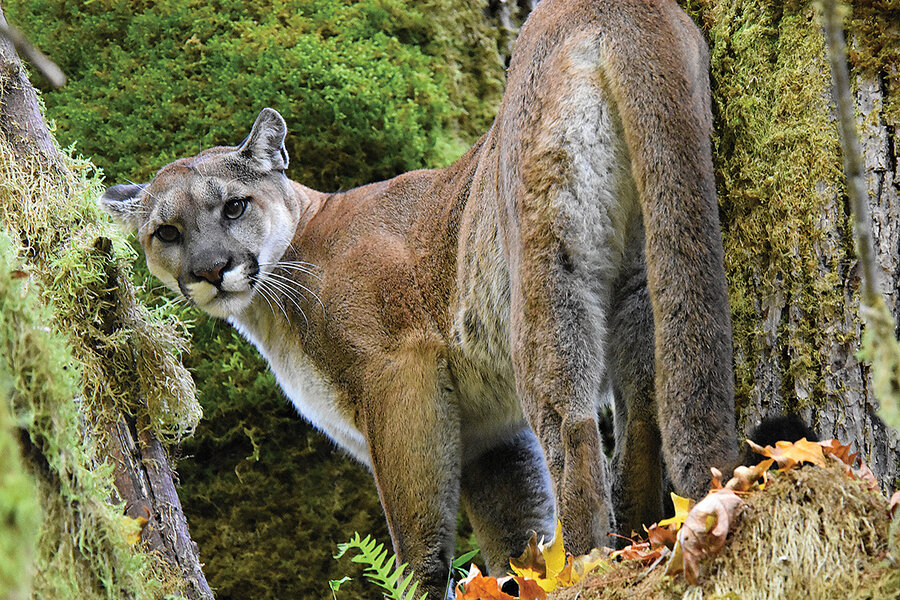How Indigenous collaboration is saving the cougar
Loading...
| Port Angeles, Wash.
If Kim Sager-Fradkin didn’t have to write a grant proposal, she’d be spending her afternoon on the trail of a killer.
The biologist leads a team that’s researching cougars in Washington’s Olympic Peninsula. It’s tempting to call her a CSI – cougar scene investigator – but her formal title is wildlife program manager for the Lower Elwha Klallam Tribe.
Why We Wrote This
A story focused onHow do you free a predator hemmed in by human development? In Washington state, scientists and Native American tribes are working to find a solution for trapped cougars.
She’s overseeing the Olympic Cougar Project in partnership with Panthera, a nonprofit that protects species of big cats, and five other Native American tribes. They’ve pooled their talents and resources to help an apex predator that has become effectively imprisoned in the westernmost part of Washington.
The region’s cougars are penned inside a geographical island roughly shaped like a square. Three sides are bordered by the ocean and bays. To the south there’s the expansive Columbia River as well as Interstate 5. By collecting data on the big cats, the Olympic Cougar Project is bolstering the case for constructing a wildlife overpass over I-5 so that the species is less confined.
“By protecting and understanding habitats used by cougars, we are protecting and understanding habitats used by a lot of other animals,” says Ms. Sager-Fradkin. “It’s big-picture conservation.”
If Kim Sager-Fradkin didn’t have to write a grant proposal, she’d be spending her afternoon on the trail of a killer.
The biologist leads a team that’s researching cougars in Washington’s Olympic Peninsula. (The big cat is also referred to as a puma or a mountain lion.) Today, the team is tracking a cougar named James. It suspects he recently hunted an animal in a nearby forest.
“Visiting cougar kill sites is really fun and like being sort of a forensic scientist,” says Ms. Sager-Fradkin.
Why We Wrote This
A story focused onHow do you free a predator hemmed in by human development? In Washington state, scientists and Native American tribes are working to find a solution for trapped cougars.
It’s tempting to call her a CSI – cougar scene investigator – but her formal title is wildlife program manager for the Lower Elwha Klallam Tribe. She’s overseeing the Olympic Cougar Project in partnership with Panthera, a nonprofit that protects species of big cats, and five other Native American tribes. They’ve pooled their talents and resources to help an apex predator that has become effectively imprisoned in the westernmost part of Washington.
The region’s cougars are penned inside a geographical island roughly shaped like a square. Three sides are bordered by the ocean and bays. To the south there’s the expansive Columbia River as well as Interstate 5. The barriers on all four sides collectively form a de facto fence. Unable to easily connect with other big cats in the Pacific Northwest, cougars in the Olympic Peninsula are inbreeding. The lack of genetic diversity poses health challenges for them, scientists say. By collecting data on the big cats, the Olympic Cougar Project is bolstering the case for constructing a wildlife overpass over I-5 so that the species is less confined.
“Humans love wildlife stories, and humans love wildlife movements,” says biologist Jim Williams, author of “Path of the Puma: The Remarkable Resilience of the Mountain Lion.” “What’s really neat about this project is it’s going to create information that will be translated through story that will keep humans excited and caring about the species.”
Inside a conference room at the Lower Elwha Klallam Tribe’s Natural Resources Department, Ms. Sager-Fradkin and fellow biologist Dave Manson swap stories about their favorite cougars. They both have affection for Bramble, a mother of multiple litters who once survived being hit by a car going 55 mph. She also managed to discard the GPS collar they’d put on her.
“She’s feisty,” marvels Ms. Sager-Fradkin. “She outsmarts us all the time. We can’t get a collar on her again. We’ve tried.”
When Ms. Sager-Fradkin began working for the tribe in 2007, her primary role was to plan sustainable subsistence hunting and fishing for current and future generations. A year later, she initiated a small-scale study of cougars in the region. She called in cougar expert Mark Elbroch. In 2018, they expanded the scope and scale, incorporating the five other tribes in the region and adopting the Olympic Cougar Project name.
“The tribes on the peninsula aren’t always working together on a lot of things,” says Ms. Sager-Fradkin, adding that there are sometimes disagreements over issues such as hunting jurisdictions. “So it’s really amazing that we’ve all come together and are working on a big project like this.”
To get all the partners on board, she had to get them to see the big picture.
In the field
On a June afternoon, Mr. Manson heads out to conduct fieldwork while his boss writes the grant proposal.
He parks his SUV on a dirt road, picks up a hand-held GPS unit, and plunges into a forest. Surefooted and nimble, the biologist clambers over fallen tree trunks and uneven terrain. The few shards of sunlight that pierce the leaf canopy cast glitter-ball shapes on the bracken. GPS signals indicate that James, who is collared, has been spending a lot of time in this particular spot.
It doesn’t take long for Mr. Manson to find what untrained eyes would miss – the burial site of a fawn. The cougar covered it up with sticks and branches. The biologist conjectures that a scavenger ate the rest of the remains. “I’m guessing a bear,” he says, doing his best to ignore mosquitoes swarming around him.
The cougars are considered an “umbrella species” because so many other creatures in the ecosystem depend on them. “Where there are frequent kills, the grass is literally more nutrient rich,” explains Ms. Sager-Fradkin. “All the way up to the bears and eagles and everything else. ... A lot of other animals are getting food from cougar kills.”
It was this fact that helped her persuade the region’s tribes that it was in their common interest to study the feline carnivore.
For his part, Dr. Elbroch, director of the puma program at Panthera, adds that Ms. Sager-Fradkin used her natural skill of engaging with people to build a community. “What was so essential to seeing this project succeed was that network,” he says during a Zoom interview. “Without it, it was a nonstarter.”
“Wildlife all is intertwined”
Working in concert, the Skokomish, Makah, Quinault, Jamestown S’Klallam, and Lower Elwha Klallam tribes have created a grid consisting of 550 cameras. Artificial intelligence catalogs animals photographed in the peninsula – including bobcats, bears, coyotes, deer, and elk – and helps estimate their populations. Research technicians, such as Lower Elwha Klallam tribe member Vanessa Castle, analyze the patterns of 127 individual cougars. There’s also the less glamorous task of analyzing animal scat.
“A lot of our ancestral knowledge was lost,” says Ms. Castle, who praises how Ms. Sager-Fradkin has mentored her and other employees in the project. “So we’re having to relearn those things. Like how wildlife all is intertwined with each other. ... I had no idea the role that mountain lions played in the system as a whole.”
The cougar is still a relatively unknown species. The cats can be found in 28 countries across the Americas. “This species is fiercely independent,” says Dr. Elbroch. “Agile, strong, curious, but incredibly cautious. They’re, of course, masters of invisibility.”
The tagged cougars aren’t, however, hidden to the satellites that track them. The Olympic Cougar Project has been able to document numerous examples of how individual cats have roamed hundreds miles in unsuccessful bids to find a way out of the region.
“They’re coming up with some really interesting information, which doesn’t surprise me because this species is so adaptable,” says biologist Maurice Hornocker, author of the memoir “Cougars on the Cliff: One Man’s Pioneering Quest To Understand the Mythical Mountain Lion.”
“They can live on the Olympic Peninsula,” he says, “and they can live in Death Valley. They can even live in Los Angeles.”
Dr. Elbroch says conservation groups are in talks with Washington state about two potential options for a wildlife bridge or underpass on I-5.
“The first thing that is needed is to protect the habitat on either side, because you can’t spend all the money on a wildlife bridge and then end up with a Walmart parking lot right on one side,” says Ms. Sager-Fradkin.
The Olympic Cougar Project is not just liberating the big cats, she adds, but also creating a sustainable ecosystem for the tribes for the next seven generations.
“By protecting and understanding habitats used by cougars, we are protecting and understanding habitats used by a lot of other animals,” she says. “It’s big-picture conservation.”
“We care for something in common,” she says. “Everybody’s invested. I don’t think any of us view this as just a job.”










